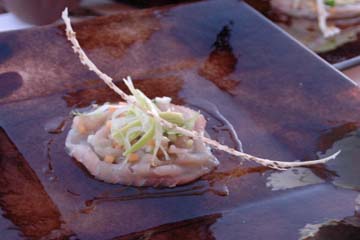by Martin Field
Capel Vale Debut Sauvignon Blanc/Semillon 2007 – up to $17 \_/\_/
Juicy ripe sauvignon nose to start. This dryish style shows kiwi fruit flavours along with oodles of lip-smacking acid. Just the thing for an aperitif to serve with canapes.
Murdoch Hill Adelaide Hills Sauvignon Blanc 2007 – up to $19 \_/\_/\_/
Cool climate, blackcurrant leaf pungency on the nose. The generous palate is full of abundant ripe sweet berries with a hint of passionfruit adding zest.
Shaw and Smith Adelaide Hills Sauvignon Blanc 2007 – around $25 \_/\_/\_/
Lychees, asparagus and just ripe apricots lead the bouquet. There is more of the lychee flavour in this full-on, mouth filling white and just a hint of pineapple. Would go well with any entrée you’d serve a squeeze of lemon with – say, fried haloumi.
Jim Barry Watervale Riesling 2007 – up to $15 \_/\_/$
A bouquet of white flowers, lime cordial and fresh grape skins. Dry on the palate, light and citrussy with zingy refreshing acidity and a firm minerally finish.
Chandon Tasmanian Cuvée 2004 – up to $40 \_/\_/\_/
Pinot noir and chardonnay from Tasmania’s Coal River Valley. Lemon green hues, busy long-lasting bead. Generous bouquet of lemons, a delicate floral note and fresh bread. The mid-dry palate shows lovely balance and length with more citrus aspects, green apple and just right acidity to finish.
Angove’s Nine Vines Shiraz Viognier 2006 – up to $15 \_/\_/
Slight purple hues. Light peppery and plum aromatics on the nose. Soft warm ((14.5% alcohol) plummy flavours and mild oakiness continue to a quite firm finish.
Hardys Oomoo Grenache/Shiraz/Mourvedre 2005 – cost $14 \_/\_/$
Fruity blackberry aromatics with an edge of anise. Blackberries, coffee, and chocolate spice up the palate supported by textured tannin chewiness.
Hanging Rock Heathcote Shiraz 2004 – $60 \_/\_/\_/\_/
A nose of intense perfumed berries and sweet vanillin oak. Full-bodied red with mulberries, a hint of mintiness and robust tannic astringency. Definitely main course wine and will cellar gracefully to 2014.
Tahbilk Reserve Shiraz 2001 – up to $60 \_/\_/\_/\_/
Tahbilk is one of the few Australian winemakers that does not depend on lashings of new oak for their reds. Their methods, including open vat fermentation, are more in tune with European tradition and the results are noticeably different from the brash young things that often reek of the barrique rather than the wine.
This wine has a complex aroma of berries compounded with pencil shavings, leather and tobacco leaf. The palate shows some bottle development and is full of savoury character with stewed plums and aniseed over a substructure of sinewy, assertively astringent tannin. Cellar to 2020.
Spitbucket rating system
Five gold spitbuckets \_/\_/\_/\_/\_/ – brilliant
\_/\_/\_/\_/ – classy
\_/\_/\_/ – first-rate
\_/\_/ – good stuff
\_/ – spit it!
An added $ or two denotes excellent value for money. Prices in Australian dollars.
